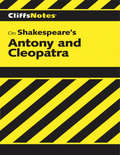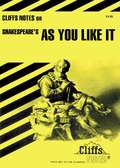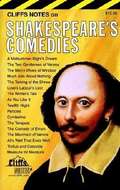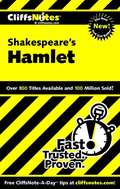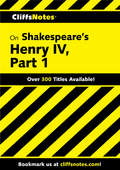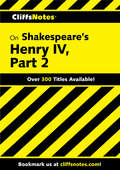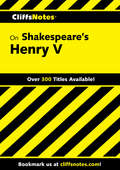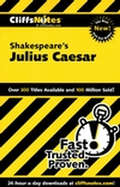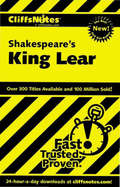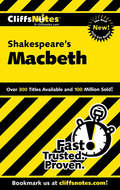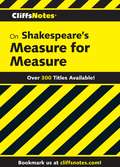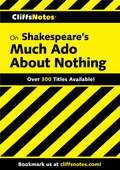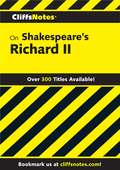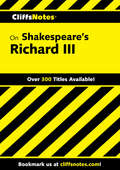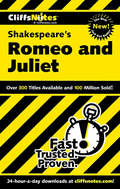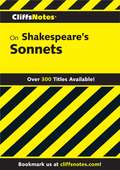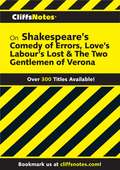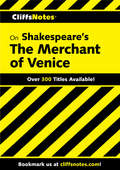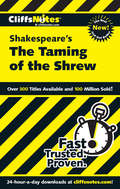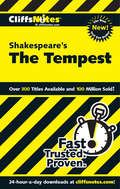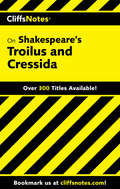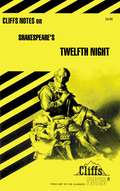- Table View
- List View
CliffsNotes on Shakespeare's All's Well That Ends Well & The Merry Wives of Windsor
by Denis M. CalandraThis CliffsNotes guide includes everything you've come to expect from the trusted experts at CliffsNotes, including analysis of the most widely read literary works.
CliffsNotes on Shakespeare's Antony and Cleopatra
by James F. Bellman Kathryn BellmanThe dilemma between heart, head, romance, and ambition has not been told with such elegance and depth as in Shakespeare's play. With revelries of poetic love and the drudgery of tragedy, this drama of the Egyptian queen and the Roman military leader is actually a microcosm of life.
CliffsNotes on Shakespeare's As You Like It
by Tom SmithAs You Like It tracks the travails of young lovers and despotic rulers as they chase one another from the palace of Duke Frederick to the Forest of Arden. Shakespeare's classic work weaves together greedy inheritors, despotic rulers, a cross-dressing princess, and some magic before drawing to a dramatic close.
CliffsNotes on Shakespeare's Comedies
by James L. Roberts Gary CareyNow available in one easy-to-access volume-- Cliffs Notes for all of Shakespeare's comedies. Includes A Midsummer-Night's Dream, The Two Gentlemen of Verona, The Merry Wives of Windsor, Much Ado About Nothing, The Taming of the Shrew, Love's Labour's Lost, The Winter's Tale, As You Like It, Twelfth Night, Pericles, Cymbeline, The Tempest, The Comedy of Errors, The Merchant of Venice, All's Well That Ends Well, Troilus and Cressida, and Measure for Measure.
CliffsNotes on Shakespeare's Hamlet
by Carla Lynn StocktonThe original CliffsNotes study guides offer expert commentary on major themes, plots, characters, literary devices, and historical background. The latest generation of titles in this series also feature glossaries and visual elements that complement the classic, familiar format.Something may be rotten in the state of Denmark, but your grades will be sweet when you rely on CliffsNotes on Hamlet as you digest Shakespeare's tragic masterpiece. In this play, Hamlet explores the meaning of life, death, eternity, relationships, hypocrisy, truth, the existence of God, and almost anything else that concerns mankind.Character studies shed new light on Prince Hamlet, his father King Hamlet, the malevolent Claudius, the troubled Ophelia -- and the rest of the cast. You'll also explore the life and times of William Shakespeare, and unlock the play's themes and literary devices. Count on CliffsNotes on Hamlet for detailed summaries and commentaries on every scene to help you appreciate the complexity of the play.Other features that help you study include Character analyses of major playersA character map that graphically illustrates the relationships among the charactersCritical essaysA review section that tests your knowledgeClassic literature or modern modern-day treasure -- you'll understand it all with expert information and insight from CliffsNotes study guides.
CliffsNotes on Shakespeare's Hamlet
by Carla Lynn StocktonThe original CliffsNotes study guides offer expert commentary on major themes, plots, characters, literary devices, and historical background. The latest generation of titles in this series also feature glossaries and visual elements that complement the classic, familiar format.Something may be rotten in the state of Denmark, but your grades will be sweet when you rely on CliffsNotes on Hamlet as you digest Shakespeare's tragic masterpiece. In this play, Hamlet explores the meaning of life, death, eternity, relationships, hypocrisy, truth, the existence of God, and almost anything else that concerns mankind.Character studies shed new light on Prince Hamlet, his father King Hamlet, the malevolent Claudius, the troubled Ophelia — and the rest of the cast. You'll also explore the life and times of William Shakespeare, and unlock the play's themes and literary devices. Count on CliffsNotes on Hamlet for detailed summaries and commentaries on every scene to help you appreciate the complexity of the play.Other features that help you study include Character analyses of major playersA character map that graphically illustrates the relationships among the charactersCritical essaysA review section that tests your knowledgeClassic literature or modern modern-day treasure — you'll understand it all with expert information and insight from CliffsNotes study guides.
CliffsNotes on Shakespeare's Henry IV, Part 1
by James K LowersThis popular play entertains and inspires in alternating comic scenes and serious ones and is the birthplace of one of the theater's greatest characters, Sir John Falstaff. Young Prince Hal rebels against his father the king until he must go to the king's aid to stamp out the rebellion of nobles.
CliffsNotes on Shakespeare's Henry IV, Part 2
by James K LowersThis popular play entertains and inspires in alternating comic scenes and serious ones and is the birthplace of one of the theater's greatest characters, Sir John Falstaff. Young Prince Hal rebels against his father the king until he must go to the king's aid to stamp out the rebellion of nobles.
CliffsNotes on Shakespeare's Henry V
by Jeffrey FisherThe original CliffsNotes study guides offer expert commentary on major themes, plots, characters, literary devices, and historical background. The latest generation of titles in this series also feature glossaries and visual elements that complement the classic, familiar format.In CliffsNotes on Henry V (the final play in Shakespeare's political tetralogy), you once again meet young Prince Hal who is now the ideal Christian monarch, King Henry V. To retain power and increase revenue, he finds he must lead his soldiers in battle against France to reclaim land and titles.A character study on King Henry V and a close look at sixteenth century politics shed light on the Bard's intentions for the play. You'll also explore synopses of the three related history plays that lead up to Henry V. Count on CliffsNotes on Henry V for detailed summaries and commentaries on every scene to help you appreciate the complexity of the play.Other features that help you study include A list of characters and their rolesAn interactive quizEssay topics and review questionsClassic literature or modern modern-day treasure — you'll understand it all with expert information and insight from CliffsNotes study guides.
CliffsNotes on Shakespeare's Julius Caesar
by Martha Perry James E. VickersThe original CliffsNotes study guides offer summaries and expert commentary on major themes, plots, characters, literary devices, and historical background. The latest generation of titles in this series also feature glossaries and visual elements that complement the classic, familiar format.In CliffsNotes on Julius Caesar, you follow the dramatic political battles of Rome during the height of the Pax Romanum. Shakespeare pits Caesar against an untold number of conspirators and lets the daggers fly. In the end, who will carry on the rule of the Caesars?This user-friendly guide makes studying a snap -- with visual icons flagging key themes, literary devices, and more. You'll come to understand the overall structure of the play, actions and motivations of the characters, and the social and cultural perspectives of the author. Features that help you study includeShakespeare's background and career highlightsScene-by-scene summariesCharacter analyses of major playersA character map that graphically illustrates the relationships among the charactersCritical essaysA review section that tests your knowledgeGlossaries of key words and termsClassic literature or modern modern-day treasure -- you'll understand it all with expert information and insight from CliffsNotes study guides.
CliffsNotes on Shakespeare's King Lear
by Sheri MetzgerThe original CliffsNotes study guides offer expert commentary on major themes, plots, characters, literary devices, and historical background. The latest generation of titles in this series also feature glossaries and visual elements that complement the classic, familiar format. In CliffsNotes on Shakespeare's King Lear, you explore one of Shakespeare's greatest tragedies - the gripping story of greed, treachery, and murder among sisters; and the foolhardiness and revelation of a father. This study guide carefully walks you through every twist and turn of Shakespeare's classic by providing summaries and critical analyses of each act and scene of the play. You'll also explore the life and background of the "Bard" himself -- William Shakespeare. Other features that help you study include Character analyses of major players A character map that graphically illustrates the relationships among the characters Critical essays A review section that tests your knowledge Glossaries of difficult words and phrases Classic literature or modern modern-day treasure - you'll understand it all with expert information and insight from CliffsNotes study guides.
CliffsNotes on Shakespeare's Macbeth
by Alex WentThe original CliffsNotes study guides offer expert commentary on major themes, plots, characters, literary devices, and historical background. The latest generation of titles in this series also feature glossaries and visual elements that complement the classic, familiar format.Packed with action and vivid portrayal of human relationships, Shakespeare's Macbeth traces the bloody climb to power and tragic ruin of a fate-plagued king. Count on CliffNotes on Macbeth to carry you through the rise and fall of a cast of characters that includes a cruel and ambitious warrior, his wicked wife, and a trio of witches who have wormed their way into audiences' hearts since William Shakespeare first presented their prophecies about 300 years ago.Show your classmates - and your grade-granting teacher - that you're in the know with English literature. You can't miss with scene summaries, plot explorations, language simplification, and insights into the author's life and times. Other features that help you study includeA brief synopsis of the playA character map to help you see relationships among the charactersCritical essays on major themes and stage productionsAn interactive quiz to test your knowledgeEssay topics and practice projectsClassic literature or modern modern-day treasure - you'll understand it all with expert information and insight from CliffsNotes study guides.
CliffsNotes on Shakespeare's Measure For Measure
by L. L. HillegassThis CliffsNotes guide includes everything you’ve come to expect from the trusted experts at CliffsNotes, including analysis of the most widely read literary works.
CliffsNotes on Shakespeare's Much Ado About Nothing
by Richard O PetersonOne of Shakespeare's romantic comedies, this play is set in the seaport town of Messina, in Sicily. The drama concerns "the battle of the sexes" and focuses on the barbed wits and intrigues that two sets of lovers and their friends and family create. Brimming with wit and antagonism, the play has amused and provoked audiences for centuries.
CliffsNotes on Shakespeare's Richard II
by Denis M. CalandraThis CliffsNotes guide includes everything you’ve come to expect from the trusted experts at CliffsNotes, including analysis of the most widely read literary works.
CliffsNotes on Shakespeare's Richard III
by James K LowersThis CliffsNotes guide includes everything you've come to expect from the trusted experts at CliffsNotes, including analysis of the most widely read literary works. Richard of Gloucester crosses and double-crosses friends and foes alike in a no-holds-barred effort to solidify control of the throne once occupied by his brother, Edward IV. His antics prove fruitful until one final battle with Henry, Earl of Richmond, at the end of the War of the Roses.
CliffsNotes on Shakespeare's Romeo and Juliet
by Annaliese F. ConnollyThe original CliffsNotes study guides offer expert commentary on major themes, plots, characters, literary devices, and historical background. The latest generation of titles in this series also feature glossaries and visual elements that complement the classic, familiar format.In CliffsNotes on Shakespeare's Romeo and Juliet, you explore Shakespeare's greatest tragedy -- the heartbreaking love story of Romeo and Juliet amid the conflict between their two feuding families, the Montagues and the Capulets.This study guide carefully walks you through every twist and turn of Shakespeare's classic by providing chapter summaries and critical analyses of each act and scene of the play. You'll also explore the life and background of the "Bard" himself -- William Shakespeare. Other features that help you study include: Character analyses of major players, A character map that graphically illustrates the relationships among the characters, Critical essays, The history of the play's development, as well as its first performance, A review section that tests your knowledge, A Resource Center full of books, articles, films, and Internet sites, Classic literature or modern modern-day treasure -- you'll understand it all with expert information and insight from CliffsNotes study guides.
CliffsNotes on Shakespeare's Sonnets
by Carl SennaNumbering more than 150, Shakespeare's sonnets have contributed significantly to discussions of the elusive character of the Bard. While most of the poems are addressed to a young man, others invoke the renowned Dark Lady. Each sonnet is interpreted, focusing on language particular to the poem, as well as on how the sonnet form furthers meaning. In addition, Shakespeare's major themes of love and beauty; mutability; and time and immortality are explored.
CliffsNotes on Shakespeare's The Comedy of Errors, Love's Labour's Lost & The Two Gentlemen of Verona
by Denis M. CalandraThis CliffsNotes guide includes everything you've come to expect from the trusted experts at CliffsNotes, including analysis of the most widely read literary works.
CliffsNotes on Shakespeare's The Merchant of Venice
by Waldo F McneirThe original CliffsNotes study guides offer expert commentary on major themes, plots, characters, literary devices, and historical background.In CliffsNotes on The Merchant of Venice, you follow along as a young merchant cannot repay his debt to a vindictive moneylender.This is the story that introduces us to Shylock, one of the most vivid and memorable characters in Shakespeare's work. You'll gain insight into this romantic comedy as you move through each of the play's five acts. Other features that help you figure out this important work includeLife and background of the authorAnalyses of the charactersA brief synopsis of the playA review section that tests your knowledgeA selected bibliography that leads you to more great resourcesClassic literature or modern-day treasure — you'll understand it all with expert information and insight from CliffsNotes study guides.
CliffsNotes on Shakespeare's The Taming of the Shrew
by Kate MaurerThe original CliffsNotes study guides offer expert commentary on major themes, plots, characters, literary devices, and historical background. The latest generation of titles in this series also feature glossaries and visual elements that complement the classic, familiar format. In CliffsNotes on The Taming of the Shrew, you explore one of Shakespeare's most beloved, and imitated, works. In this play within a play, Petruchio, the man from Verona, marries Kate (the shrew of the story), so that Kate's younger sister Bianca may be allowed to take on several suitors and choose one to marry. Summaries and commentaries lead you, act by act, through this Shakespearean classic, and critical essays give you insight into Shakespeare's historical basis for the play, as well as role playing in The Taming of the Shrew. Other features that help you study include Character analyses of the main characters A character map that graphically illustrates the relationships among the characters A section on the life and background of William Shakespeare A review section that tests your knowledge A ResourceCenter full of books, articles, films, and Internet sites Classic literature or modern modern-day treasure -- you'll understand it all with expert information and insight from CliffsNotes study guides.
CliffsNotes on Shakespeare's The Tempest
by Sheri MetzgerThe original CliffsNotes study guides offer expert commentary on major themes, plots, characters, literary devices, and historical background. The latest generation of titles in this series also feature glossaries and visual elements that complement the classic, familiar format. In CliffsNotes on The Tempest, you follow the famous story of Prospero and his daughter Miranda. Through magic, Prospero conjures up a storm that brings a ship full of his enemies to the island on which he and Miranda live. What follows is Shakespeare's comic masterpiece that's full of intrigue and romance. Summaries and commentaries lead you, act by act, through this Shakespearean classic, and critical essays give you insight into the play as a political romance. Other features that help you study include Character analyses of the main characters A character map that graphically illustrates the relationships among the characters A section on the life and background of William Shakespeare A review section that tests your knowledge A ResourceCenter full of books, articles, films, and Internet sites Classic literature or modern modern-day treasure -- you'll understand it all with expert information and insight from CliffsNotes study guides.
CliffsNotes on Shakespeare's The Tempest
by Sheri MetzgerThe original CliffsNotes study guides offer expert commentary on major themes, plots, characters, literary devices, and historical background. The latest generation of titles in this series also feature glossaries and visual elements that complement the classic, familiar format. In CliffsNotes on The Tempest, you follow the famous story of Prospero and his daughter Miranda. Through magic, Prospero conjures up a storm that brings a ship full of his enemies to the island on which he and Miranda live. What follows is Shakespeare's comic masterpiece that's full of intrigue and romance. Summaries and commentaries lead you, act by act, through this Shakespearean classic, and critical essays give you insight into the play as a political romance. Other features that help you study include Character analyses of the main characters A character map that graphically illustrates the relationships among the characters A section on the life and background of William Shakespeare A review section that tests your knowledge A ResourceCenter full of books, articles, films, and Internet sites Classic literature or modern modern-day treasure -- you'll understand it all with expert information and insight from CliffsNotes study guides.
CliffsNotes on Shakespeare's Troilus and Cressida
by James K LowersThis CliffsNotes guide includes everything you&’ve come to expect from the trusted experts at CliffsNotes, including analysis of the most widely read literary works.
CliffsNotes on Shakespeare's Twelfth Night
by James L RobertsThe original CliffsNotes study guides offer expert commentary on major themes, plots, characters, literary devices, and historical background. The latest generation of titles in this series also feature glossaries and visual elements that complement the classic, familiar format. In CliffsNotes on Twelfth Night, you follow several separate groups of characters whose stories are flawlessly woven together to produce one of Shakespeare's lightest, most popular, and most musical comedies -- full of intricate plots and subplots and witty banter that only Shakespeare could write. Summaries and commentaries take you through Shakespeare's masterpiece, and character analyses of such memorable characters as Viola, Olivia, and Duke Orsino clue you in on their motivations. You also get these additional features: A section on the life and background of William Shakespeare A review section that tests your knowledge A selected bibliography Classic literature or modern modern-day treasure -- you'll understand it all with expert information and insight from CliffsNotes study guides.

